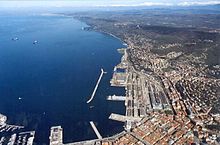
Back اقتصاديات البن Arabic Économie du café French 커피의 경제학 Korean Економіка кави Ukrainian Kinh tế cà phê Vietnamese 咖啡經濟學 Chinese


Coffee is a popular beverage and an important commodity. Tens of millions of small producers in developing countries make their living growing coffee. Over 2.25 billion cups of coffee are consumed in the world daily. Over 90 percent of coffee production takes place in developing countries — mainly South America — while consumption happens primarily in industrialized economies. There are 25 million small producers who rely on coffee for a living worldwide. In Brazil, where almost a third of the world's coffee is produced, over five million people are employed in the cultivation and harvesting of over three billion coffee plants; it is a more labor-intensive culture than alternative cultures of the same regions, such as sugar cane or cattle, as its cultivation is not automated, requiring frequent human attention.
Coffee is a major export commodity and was the top agricultural export for 12 countries in 2004; the world's seventh-largest legal agricultural export, by value, in 2005; and "the second most valuable commodity exported by developing countries," from 1970 to circa 2000,[1][2] which is frequently misstated — see coffee commodity market.[3][4] Unroasted, or green, coffee beans comprise one of the most traded agricultural commodities in the world;[5] the commodity is traded in futures contracts on many exchanges, including the New York Board of Trade, New York Mercantile Exchange, New York Intercontinental Exchange. Important trading and processing centers for coffee in Europe are Hamburg and Trieste.
- ^ Talbot, John M. (2004). Grounds for Agreement: The Political Economy of the Coffee Commodity Chain. Rowman & Littlefield. p. 50.
So many people who have written about coffee have gotten it wrong. Coffee is not the second most valuable primary commodity in world trade, as is often stated. [...] It is not the second most traded commodity, a nebulous formulation that occurs repeatedly in the media. Coffee is the second most valuable commodity exported by developing countries.
- ^ Pendergrast, Mark (April 2009). "Coffee: Second to Oil?". Tea & Coffee Trade Journal: 38–41. Archived from the original on 10 July 2014. Retrieved 27 May 2014.
- ^ Pendergrast, Mark (1999). Uncommon Grounds: The History of Coffee and How It Transformed Our World. New York: Basic Books. ISBN 978-0-465-03631-8.
- ^ "FAOSTAT Core Trade Data (commodities/years)". FAO Statistics Division. 2007. Archived from the original on 14 October 2007. Retrieved 24 October 2007. To retrieve export values: Select the "commodities/years" tab. Under "subject", select "Export value of primary commodity." Under "country," select "World." Under "commodity," hold down the shift key while selecting all commodities under the "single commodity" category. Select the desired year and click "show data." A list of all commodities and their export values will be displayed.
- ^ Mussatto, Solange I.; Machado, Ercília M. S.; Martins, Silvia; Teixeira, José A. (2011). "Production, Composition, and Application of Coffee and Its Industrial Residues". Food and Bioprocess Technology. 4 (5): 661–72. doi:10.1007/s11947-011-0565-z. hdl:1822/22361. S2CID 27800545.
© MMXXIII Rich X Search. We shall prevail. All rights reserved. Rich X Search